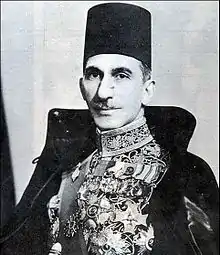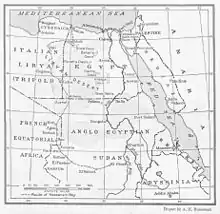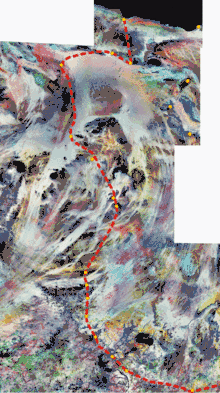Ahmed Hassanein
Ahmed Hassanein Pasha, KCVO, MBE (Arabic: أحمد حسنين باشا) (31 October 1889 – 19 February 1946)[1] or Aḥmad Moḥammad Makhlūf Ḥasanēn al-Būlākī (Arabic: أحمد محمد مخلوف حسنين البولاقى) was an Egyptian courtier, diplomat, politician, and geographic explorer. Hassanein was the tutor, Chief of the Diwan and Chamberlain to Farouk, the king of Egypt from 1936 to 1952, and also represented Egypt in the 1924 Summer Olympics in fencing.

Early life
Hassanein was born in 1889, the son of an Al-Azhar University professor, and grandson of the last Admiral of the Egyptian fleet before it was dismantled under British occupation in 1882. He studied at Balliol College of Oxford University.
Tutor
King Fuad I, father of Farouk, chose Hassanein to tutor the Crown Prince during the Prince's studies as a teenager in London. While Fuad spoke Turkish as his mother-tongue and was therefore unable to eloquently address his own nation, Farouk learned to speak Arabic proficiently under Hassanein's coaching.
Expeditions


During an expedition through the Libyan Desert in 1923, Ahmed Hassanein crossed a region defended by the puritanical Senussis.

Hassanein's first journey was to the Kufra, the Senussi's oasis capital. The journey nearly ended in disaster due to companion Rosita Forbes making an error reading the compass.
In December 1922, Hassanein began a new scientific expedition from Sallum. He recorded bearings and measures of distances, took photos, samples, wrote his journal, and interacted with his men to learn more about their traditions and places and natural phenomena. He corrected the position of his destination of Kufra on maps, and at the climax of his expedition discovered previously unknown water sources, the "Lost Oases" of Jebel Uweinat and Jebel Arkenu, which opened new Sahara routes from Kufra to Sudanic Africa. The latter was known since 1892 through Arab sources,[2] but the former was not even known to the Senussis he visited in Kufra. During the journey he took photographys of significant rock art.
In September 1924, his report was published in the National Geographic Magazine with 47 photos and a map. His book, The Lost Oases, was published the following year in English and later in Arabic and German.
Ahmed's work based on his journeys includes: an accurate map of a then-unknown region, based on astro-fixing and triangulation techniques; writings on the history and traditions of the isolated and fiercely independent Senussis sect in Libya; a widely published memoir; a geological collection; and thousands of photos and hours of footage. He was honoured with the title of Bey and the prestigious Founder's Gold Medal of the British Royal Geographical Society in 1924.[3]
Olympics
Hassanein competed at the 1920 and 1924 Summer Olympics in the foil and épée competitions.[4]
Hassanein mausoleum
Hassanein was buried in the Mameluke Northern Cemetery across the Salah Salem road from the new seat of the Al-Azhar Imam in a mausoleum built by his brother-in-law, the renowned architect Hassan Fathy.
Sources
- Bertarelli, L.V. (1929). Guida d'Italia, Vol. XVII (in Italian). Milano: Consociazione Turistica Italiana.
References
- Montgomery-Massingberd, Hugh, ed. (1980). "The Royal House of Egypt". Burke's Royal Families of the World (snippet view). Volume II: Africa & the Middle East. London: Burke's Peerage. p. 36. ISBN 978-0-85011-029-6. OCLC 18496936. Retrieved 1 March 2010.
- Bertarelli (1929), p. 515.
- "List of Past Gold Medal Winners" (PDF). Royal Geographical Society. Archived from the original (PDF) on 27 September 2011. Retrieved 24 August 2015.
- "Ahmed Mohamed Hassanein Olympic Results". sports-reference.com. Archived from the original on 18 April 2020. Retrieved 23 March 2010.